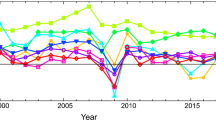Abstract
Financial, economic and sovereign debt crises have called into question macro-economic and monetary integration in Europe in general, and the future of the eurozone in particular. It is possible that even the future of the European Union (EU) as a whole is at stake. Starting with the reforms of European economic governance hitherto agreed, this article develops three scenarios for the eurozone and explores their possible impact on the EU in general. The mix of procedures, both inside and outside the EU legislative framework and with varying groups of participants, offers a starting point for the emergence of an ‘Optimal Institutional Architecture’.

Similar content being viewed by others
References
Begg, I. (2011). Fiscal union for the euro area: An overdue and necessary scenario?. Gütersloh: Bertelsmann Stiftung.
Belke, A. (2011). Doomsday for the euro area: Causes, variants and consequences of breakup. Gütersloh: Bertelsmann Stiftung, November.
Belke, A., & Gros, D. (2009). On the benefits of fiscal policy coordination in a currency union: A note. Empirica, 36, 45–49.
Chirac, J. (2000). Unser Europa. Berlin, Speech to the German Bundestag.
Collignon, S. (2010). Demokratische Anforderungen an eine europäische Wirtschaftsregierung. Friedrich-Ebert Foundation: International Policy Analysis Unit.
European Commission. (2011). Green paper on the feasibility of introducing Stability Bonds. COM 818 final. Brussels.
Fischer, J. (2000). Vom Staatenbund zur Föderation: Gedanken über die Finalität der Europäischen Integration. Speech at Humboldt University, Berlin, 12 May. In H. Marhold (Ed., 2001), Die neue Europadebatte. Leitbilder für das Europa der Zukunft (pp. 41–54). Bonn: Europa Union Verlag.
Habbel, M., Mattern, F., Windhagen, E., Mußhoff, J., Kotz, H. & Rall, W. (2012). The future of the euro: An economic perspective on the eurozone crisis. Online Publication. McKinsey & Company. January (updated version). http://www.mckinsey.de/downloads/presse/2012/The%20future%20of%20the%20euro_McKinsey%20report.pdf. Accessed 25 March 2012.
Kunstein, T., & Wessels, W. (2011). Die Europäische Union in der Währungskrise: Eckdaten und Schlüsselentscheidungen. Integration, 4, 308–322.
Mundell, R. A. (1961). A theory of optimum currency areas. The American Economic Review, 51(4), 657–665.
Piris, J. (2011). It is time for the euro area to develop further closer cooperation among its members. Jean Monnet Working Paper 05/11. New York, NYU School of Law.
Tekin, F. (2012). Differentiated integration at work: The institutionalisation and implementation of opt-outs from European integration in the AFSJ. Baden-Baden: Nomos.
Trichet, J. (2011). Building Europe, building institutions. Aachen, Speech on receiving the Karlspreis.
Author information
Authors and Affiliations
Corresponding author
About this article
Cite this article
Kunstein, T., Wessels, W. What we hope, what we fear, what we expect: possible scenarios for the future of the eurozone. European View 11, 5–14 (2012). https://doi.org/10.1007/s12290-012-0210-x
Published:
Issue Date:
DOI: https://doi.org/10.1007/s12290-012-0210-x




